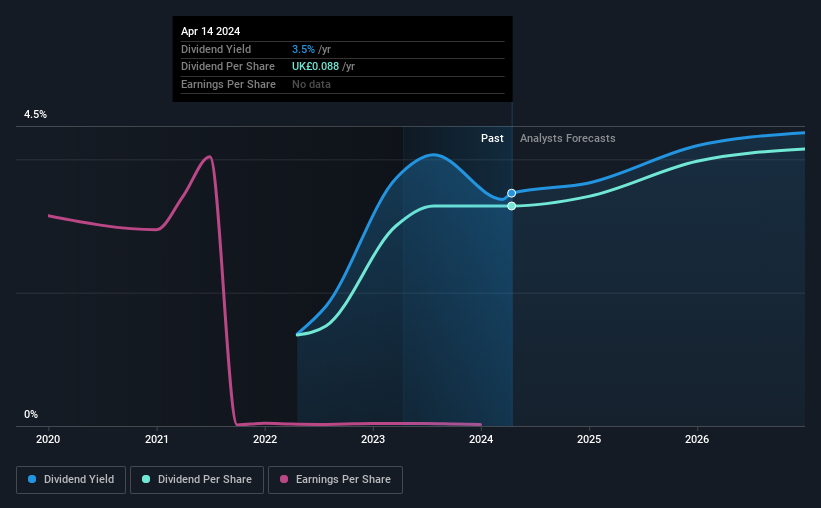Here's Why We're Wary Of Buying Bridgepoint Group's (LON:BPT) For Its Upcoming Dividend
Bridgepoint Group plc (LON:BPT) is about to trade ex-dividend in the next three days. The ex-dividend date is usually set to be one business day before the record date which is the cut-off date on which you must be present on the company's books as a shareholder in order to receive the dividend. The ex-dividend date is important as the process of settlement involves two full business days. So if you miss that date, you would not show up on the company's books on the record date. In other words, investors can purchase Bridgepoint Group's shares before the 18th of April in order to be eligible for the dividend, which will be paid on the 21st of May.
The company's next dividend payment will be UK£0.044 per share, and in the last 12 months, the company paid a total of UK£0.088 per share. Calculating the last year's worth of payments shows that Bridgepoint Group has a trailing yield of 3.5% on the current share price of UK£2.52. Dividends are a major contributor to investment returns for long term holders, but only if the dividend continues to be paid. So we need to investigate whether Bridgepoint Group can afford its dividend, and if the dividend could grow.
View our latest analysis for Bridgepoint Group
Dividends are typically paid from company earnings. If a company pays more in dividends than it earned in profit, then the dividend could be unsustainable. Bridgepoint Group paid out 101% of its earnings, which is more than we're comfortable with, unless there are mitigating circumstances.
When a company pays out a dividend that is not well covered by profits, the dividend is generally seen as more vulnerable to being cut.
Click here to see the company's payout ratio, plus analyst estimates of its future dividends.
Have Earnings And Dividends Been Growing?
When earnings decline, dividend companies become much harder to analyse and own safely. If earnings decline and the company is forced to cut its dividend, investors could watch the value of their investment go up in smoke. Bridgepoint Group's earnings per share have plummeted approximately 80% a year over the previous five years.
Many investors will assess a company's dividend performance by evaluating how much the dividend payments have changed over time. Since the start of our data, two years ago, Bridgepoint Group has lifted its dividend by approximately 55% a year on average. That's intriguing, but the combination of growing dividends despite declining earnings can typically only be achieved by paying out a larger percentage of profits. Bridgepoint Group is already paying out a high percentage of its income, so without earnings growth, we're doubtful of whether this dividend will grow much in the future.
Final Takeaway
Has Bridgepoint Group got what it takes to maintain its dividend payments? Earnings per share are in decline and Bridgepoint Group is paying out what we feel is an uncomfortably high percentage of its profit as dividends. It's not that we hate the business, but we feel that these characeristics are not desirable for investors seeking a reliable dividend stock to own for the long term. These characteristics don't generally lead to outstanding dividend performance, and investors may not be happy with the results of owning this stock for its dividend.
With that in mind though, if the poor dividend characteristics of Bridgepoint Group don't faze you, it's worth being mindful of the risks involved with this business. To help with this, we've discovered 3 warning signs for Bridgepoint Group that you should be aware of before investing in their shares.
A common investing mistake is buying the first interesting stock you see. Here you can find a full list of high-yield dividend stocks.
Have feedback on this article? Concerned about the content? Get in touch with us directly. Alternatively, email editorial-team (at) simplywallst.com.
This article by Simply Wall St is general in nature. We provide commentary based on historical data and analyst forecasts only using an unbiased methodology and our articles are not intended to be financial advice. It does not constitute a recommendation to buy or sell any stock, and does not take account of your objectives, or your financial situation. We aim to bring you long-term focused analysis driven by fundamental data. Note that our analysis may not factor in the latest price-sensitive company announcements or qualitative material. Simply Wall St has no position in any stocks mentioned.

 Yahoo Finance
Yahoo Finance 
